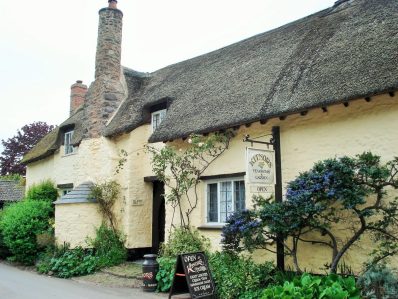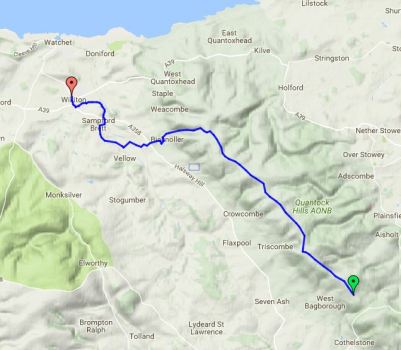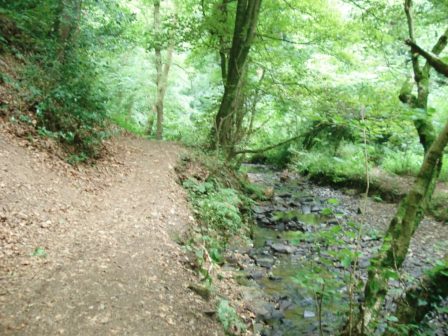Ilfracombe – Woolacombe.
The lady serving breakfast said she had been over at Woolacombe yesterday evening to catch the good surf conditions and for the next few days I felt out of place without a wet suit and board, mind you I would have looked ridiculous on the Torrs which was my first objective for the day. Reading about Ilfracombe later I found there was lots of interest there worthy of a further visit. I had walked into town following footprints and on the way out had posh finger tiles.  The morning was misty and damp and not one for hanging about so I was quickly following the Victorian pathways cut into the hillside, above tunnels leading to hidden bathing beaches. Flowers brightened the way and I was soon up to the summit of the Torrs where there was an elaborate viewfinder but no views.
The morning was misty and damp and not one for hanging about so I was quickly following the Victorian pathways cut into the hillside, above tunnels leading to hidden bathing beaches. Flowers brightened the way and I was soon up to the summit of the Torrs where there was an elaborate viewfinder but no views.




 Onwards onto open farmland the paths were difficult to follow but all seemed to go in the right direction, there is one rule in coastal walking – keep the sea on the same side. Out of the mist would appear herds of cattle whose sex I couldn’t identify which didn’t help my ‘taurophobia’.
Onwards onto open farmland the paths were difficult to follow but all seemed to go in the right direction, there is one rule in coastal walking – keep the sea on the same side. Out of the mist would appear herds of cattle whose sex I couldn’t identify which didn’t help my ‘taurophobia’.

This elaborate sign said – PUBLIC PATH. PLEASE KEEP TO IT.


?Hidden danger.
Sunken lanes lead into Lee Bay a delightful little hamlet. The hotel has seen better days and looks unlikely to reopen but across the beach was a little cafe. I was glad to get under shelter and have a hot drink. I got into conversation with a Swiss lady, from Montreux, who was out walking whilst her husband did deals for Nestlé. We talked of the Swiss Alps, gardens, families, chocolate and of course she quizzed me on Brexit, an hour or so went very pleasantly and by the time I set off the rain had stopped and the sun came out – thanks to a bit of détente!

Cafes are becoming a theme on this walk.
The next stretch of coast was undulating in and out of little bays with a few families making the best of the day. A couple were watching their girls searching the pools. They come to this area where they were married 12years ago, their reception was in that hotel which closed shortly after – they didn’t feel it was a bad omen.
At Bull Point was a lighthouse, there are some treacherous rocks on this coast. A local man said seals were often spotted along here but I failed to see any.

Bull Point.

View back to Bull Point lighthouse.
A long hot tiring trudge round Mort Point was enlightened by my first sight of Lundy Island. Lundy has special memories for me. In 2002 I spent time there climbing with a good friend Tony [and others] we did all the classics and he was delighted to lead The Devil’s Slide and particularly Diamond Solitaire a classy VS on a flying buttress coming straight out of the sea. After a great climbing trip we parted, I went off to the Alps for a month and on my return he was dying of cancer. Sobering thought.

Morte Point and distant Lundy Island.
Anyhow heading south again more and more people were met walking the paths out of Woolacombe. Most of the coast headlands today have been managed successfully by the National Trust. The beach seen ahead was one mass of people, mostly children on body boards but also well out into the higher breaking waves surfers who didn’t seem to having too much success. The car park had a lot of camper vans favoured by the surfing community. Ice creams and fishnchips seemed high on families’ priorities.

Heading to Woolacombe.

Distant headlands…




 My hostel for the night, The Beach House, was in a side street amongst the busy shops and cafes nowhere near the beach. I’d booked into a bunk room which turned out to be very smart and clean. I bought a cider and relaxed in their garden.
My hostel for the night, The Beach House, was in a side street amongst the busy shops and cafes nowhere near the beach. I’d booked into a bunk room which turned out to be very smart and clean. I bought a cider and relaxed in their garden. Asking about food, they had a good menu, I was told everywhere just about booked up but they would fit me into a table later. Into the cozy bunk room walks the American lady, she has no worries about sharing being a fellow coastal walker. We compare notes, share the dinner table, watch the sunset and drink wine. Another interesting meeting with wide ranging conversation, she is avoiding America whilst Trump in power by working and touring in Europe. A talented lass fluent in several languages and with varied careers.
Asking about food, they had a good menu, I was told everywhere just about booked up but they would fit me into a table later. Into the cozy bunk room walks the American lady, she has no worries about sharing being a fellow coastal walker. We compare notes, share the dinner table, watch the sunset and drink wine. Another interesting meeting with wide ranging conversation, she is avoiding America whilst Trump in power by working and touring in Europe. A talented lass fluent in several languages and with varied careers.
Think I spent more time chatting today than walking.
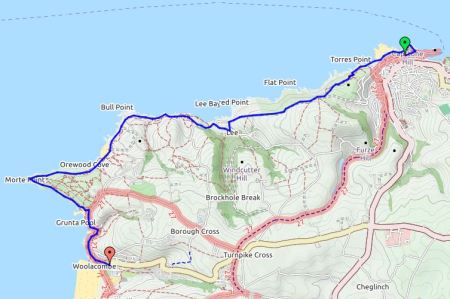

 Next thing I was face to face with a high security fence with dire warning notices. I had lost the path and stumbled into a GCHQ listening compound. There were radar domes and dishes which pointed east and west, I guess we are in the middle now, Trump and Kim Jong-un. I retreated to the coast.
Next thing I was face to face with a high security fence with dire warning notices. I had lost the path and stumbled into a GCHQ listening compound. There were radar domes and dishes which pointed east and west, I guess we are in the middle now, Trump and Kim Jong-un. I retreated to the coast.

 Relief came in one of the valleys, Sandymouth, in the form of a great little cafe but I managed to spill most of my tea.
Relief came in one of the valleys, Sandymouth, in the form of a great little cafe but I managed to spill most of my tea.
 The terrain evened out but not much of Bude bay was seen till the end as the mist slowly cleared. Looking back along the coast was dramatic. Beach huts announced the arrival of the seaside holiday resort with a few hardy souls on the beach.
The terrain evened out but not much of Bude bay was seen till the end as the mist slowly cleared. Looking back along the coast was dramatic. Beach huts announced the arrival of the seaside holiday resort with a few hardy souls on the beach. 
































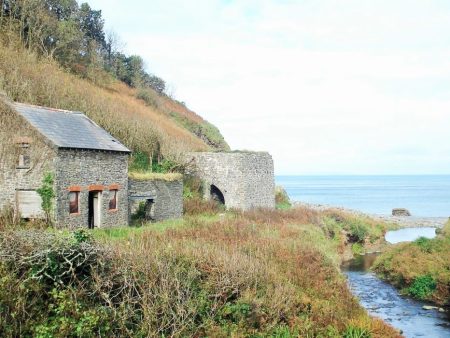








































































































































 .
.






































































